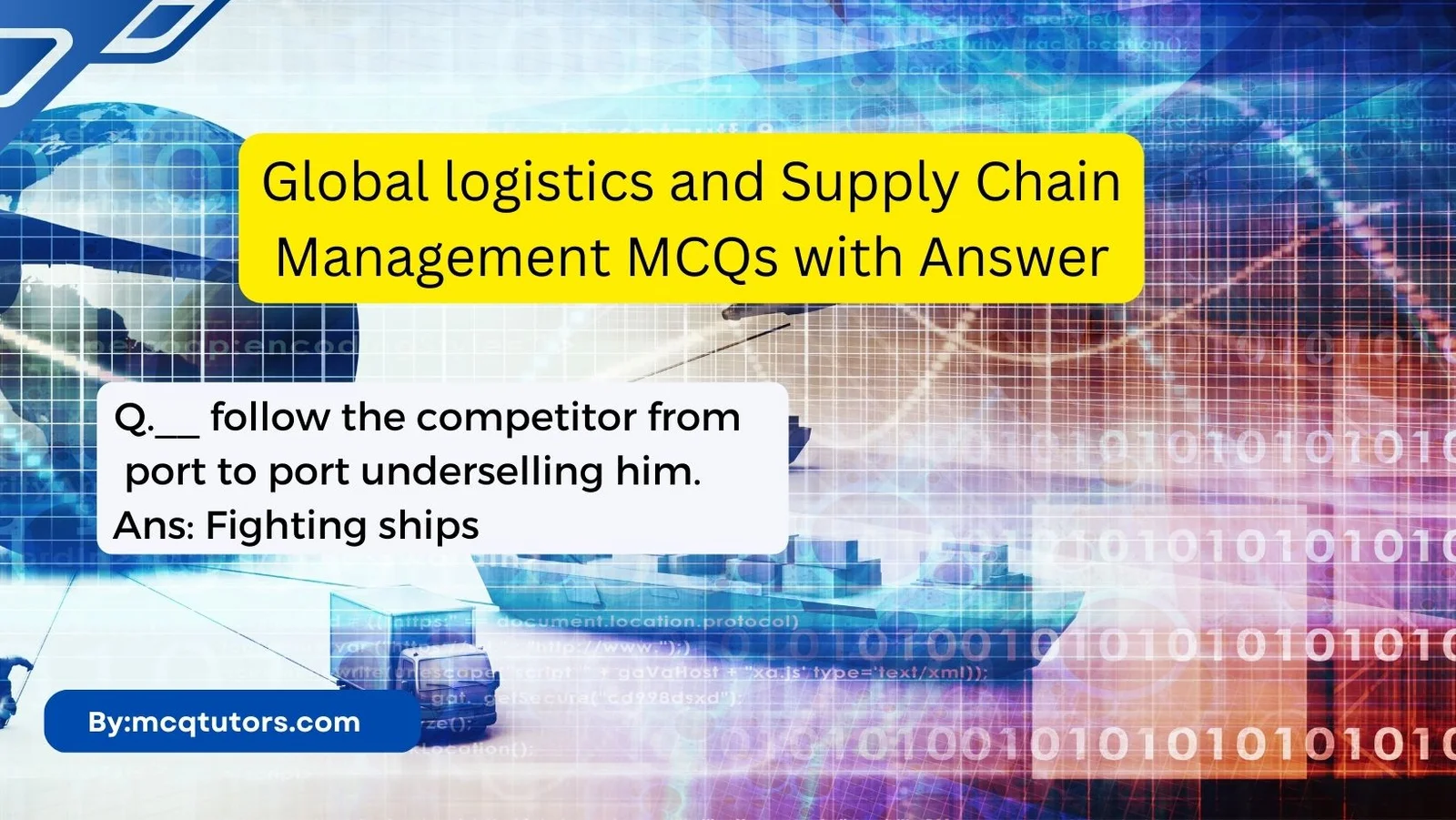Are you looking for Global logistics and Supply Chain Management MCQs with Answer? This article will provide you with multiple choice questions (MCQs) related to the topics of Global logistics and Supply Chain Management.
Knowing the answers to these questions can help you gain a better understanding of these concepts. With this article, you’ll have access to helpful resources that can aid in studying and preparing for exams.
Global logistics and Supply Chain Management MCQs with Answer
1. Vessel owners pooled or shared their profits based on ___ agreement.
Ans. Pooling
2. In U.S., strong arguments arise only supporting the conferences. (True/False)
Ans. False. There were arguments both supporting and opposing the conference.
3. The fourth page of the first agreement of the conference contains rules about _.
Ans. Internal discipline
4. is responsible for publishing freight classifications and tariffs of the conference.
Ans. Spokesperson
5. The act of members going against the conference and fixing their own prices when demand is low is__.
Ans. Independent action
6. Rationalisation is a term related to market demand. (True/False)
Ans. False. Rationalisation is a term related to conference behaviour.
7. Policing agents inspect the behaviour of the conference members and it is called .
a) Rationalisation
b) Self-policing
c) Pooling
d) Chartering
Ans. b) Self-policing
8. __ follow the competitor from port to port underselling him.
Ans. Fighting ships
9. Some vessel operator always serves profitable markets and move ships only when demand is high. It is called ___.
Ans. Skimming the cream
10. Shippers can negotiate with individual conference members. (True/False)
Ans. True
11. Vessels may look alike but they have different itineraries, trade balances, etc. (True/False)
Ans. True
12. Shippers are bound to the conference or carriers using __.
Ans. Service contracts
13. Contracts with _ are known as loyalty contracts.
Ans. Dual rates
14. Shippers’ association helps in freight consolidation and service contract negotiation. (True/False)
Ans. True
15. Shippers and conference discuss about freight classification and tariff occasionally. (True/False)
Ans. False. Shippers and conference discuss about freight classifications and tariffs periodically.
16. Conferences always face some problems with the government. (True/False)
Ans. True
17. _ are private firms that help in consolidating freights to full container load shipments.
Ans. NVOCCs
18. _ is the main source of income for freight forwarders.
Ans. Brokerage
19. According to FMC, forwarders should not collect commission from carriers. (True/False)
Ans. False. Forwarders are licensed by FMC to collect commission from carriers.
20. The type of cargo that has some similarity with bulk cargoes and break-bulk cargoes is .
Ans. Neo-bulk cargo
21. During the First World War, __started to use airplanes to transport cargo.
a) Army Signal Corps
b) Army Flying Corps
c) Air force Signal Corps
d) Air force Flying Corps
Ans. a. Army Signal Corps
22. The United States, instead of preparing itself for war during 1930s, it spent most of its time developing civil aviation. (True/False)
Ans. True
23. During ___, two most important technological developments, radar and jet aircraft, came into existence.
Ans. Second World War
24. Air cargo is kept within a safe dimensioned and contoured semi-structured covers known as _.
Ans. Type “A”
25. Cargo nets are used to secure the cargo to the __ and tensioned straps are used to tighten over the cargo.
a) Fibreboard
b) Pilferage
c) Pallet
d) Contour
Ans. c. Pallet
26. Freight forwarders are used to make use of box-type containers to consolidate shipper’s cargo into one rated unit. (True/False)
Ans. True
27. Generally air cargo containers are loaded and unloaded off the air property in ___.
Ans. Container stations
28. Dimensional weight is used for __ shipments.
a) High density
b) Low density
c) Medium density
d) Standard density
Ans. b. Low density
29. The unavoidable loss in space due to irregular shapes of the shipments is known as __.
Ans. Stacking losses
30. Competition is a major factor of importance used to determine air freight rates. (True/False)
Ans. True
31. The air waybills can be negotiated, as they are all straight consignments and must have a consignee address. (True/False)
Ans. False. The air waybills are not negotiable as they are all straight consignments and must have a consignee address.
32. The seller’s and buyer’s firm may have certain ___ to cover their goods during the transit phase.
Ans. Blanket policies
33. The movement of import goods is opposite to that of the .
Ans. Export goods
34. Intermodalism has achieved __ by linking the individual modes of transports.
a) Greater accessibility
b) Global trade facility
c) Overall cost efficiency
d) Electronic tracking
Ans. a) Greater accessibility
35. The speed and accessibility of _ is helpful for initial pickup and final delivery of the product.
Ans. Trucks
36. __ is designed to carry containers in cells aboard through ship. (Pick the right option)
a) Tugboat
b) Containership
c) Truck trailer
d) Barge
Ans. b) Containership
37. Intermodal movement by rail helps in long distance movement of containers or truck trailers. (True/False)
Ans. True
38. Both government and small industrialists are focusing on work force development. (True/False)
Ans. False. Both government and small industrialists are not focusing on work force development.
39. _ handles almost all rail container traffic in India.
Ans. Container Corporation of India
40. Inland Container Depots and __ are also known as dry ports.
Ans. Container Freight Stations
41. ___ refers to the physical movement of goods from the manufacturer or supplier to the customer.
Ans. Outbound Logistics
42. Business organisations use the result of demand forecasting to estimate the amount of sale in the global market. (True/False)
Ans. False. Demand forecasting is used to estimate the customer demand.
43. Labelling is usually done in the language of the nation to which the product is exported. (True/False)
Ans. True
44. also covers the payment status of the product that is associated with shipment.
a) Documentation
b) Labelling
c) Packaging
d) Order
Ans. b) Documentation
45. It is necessary for an organisation to plan the production schedule based on the and _.
Ans. Plant competence, accessibility
46. Who has to ensure that the goods arrive in good condition and reaches on time? (Pick the right option)
a) Logistics manager
b) 3PL
c) Vendor
d) Buyer
Ans. a) Logistics manager
47. If the vendor manages the delivery of goods, the buyer should keep track of the delivery performance. (True/False)
Ans. True
48. The loss of inventory between the point of manufacturing and the point of sale is called _.
Ans. Inventory shrinkage
49. ___ is the process of keeping track of shipment and delayed or misplaced goods.
a) Expediting
b) Tracing
c) Inventory shrinkage
d) Cartons
Ans. b) Tracing
50. Water is the expensive and fastest mode of transportation. (True/False)
Ans. False. Air is the expensive and fastest mode of transportation.
You may like Marketing Management Quiz
Conclusion
Global logistics and supply chain management MCQs with answers is a great resource for those looking to understand the complexities of this field. With easy to understand questions and clear answers, it provides an accessible way for anyone to gain a better understanding of the key concepts.
Moreover, these questions can help industry professionals identify areas where they can improve their knowledge and skills. By addressing their weaknesses in this area, they can be better prepared for career advancement or other opportunities that may come up.
Read More MCQs
- Maintenance Management MCQs
- Quality Control and Quality Assurance MCQs
- Production and Operations Management MCQs
- Business Planning and Project Management MCQs




